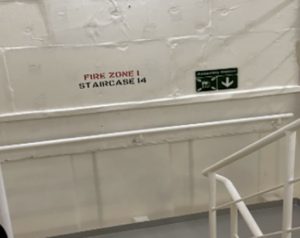The Charity
Aviation
Maritime
M2121

Initial Report
This report was submitted by a passenger on a cruise ship and concerns passenger evacuation procedures and access to lifesaving equipment.
The reporter stated that they were frequent travellers on passenger ships and had concerns about varying safety standards between cruise liner companies. Of particular concern on one cruise were the following issues:
The mandatory passenger emergency muster drill before departure needed to be better organised. Signage must be clarified, and the presence of crewmembers to guide passengers to their muster stations must be included in some sectors of the evacuation route. The captain’s safety speech could have been clearer on where to go and what to do in an emergency. Life jacket signs were posted in the stateroom, but there were no life jackets, raising concerns about passenger familiarisation and safety in an emergency.
The reporter felt that more crew training was required on emergency procedures, including passenger evacuation, but noted that due to the high turnover of crew due to the pandemic, some experience was lacking.
Also, fatigue could be a problem for some crew members with many tasks. The reporter stated that regular drills should be conducted in both crew spaces and passenger areas to ensure preparedness.
CHIRP Comment
CHIRP thanks the reporter for highlighting what they perceived as the inadequacies of the passenger muster drill before departure.
The muster drill is a fundamental safety procedure that should familiarise all passengers and crew with emergency evacuation protocols. It serves to instil confidence and provide reassurance, especially for individuals who are new to cruising.
The amended regulation III/19 in the International Convention for the Safety of Life at Sea (SOLAS) mandates that all passengers must participate in safety drills, including mustering at lifeboat stations, before or immediately upon departure. Cruise companies are responsible for conducting these drills efficiently and effectively to ensure everyone knows their emergency muster and evacuation locations.
The muster drill should be allocated adequate time to ensure passengers and crew fully understand the procedures. Crewmembers must be trained to guide passengers to their designated muster stations
confidently. They should be able to respond to queries raised by passengers.
Clear and visible signage and instructions throughout the ship are crucial to assist passengers during emergencies. These should help passengers to locate their muster stations and understand evacuation routes quickly.
Recognising the demanding and stressful nature of work on a ship, it is essential to manage crew workload and consider the experience level of crewmembers. Fatigue, stress, and a high workload can impede the crew’s ability to focus on safety protocols.
CHIRP encourages passengers to seek guidance from the crew if they require additional clarification about the evacuation procedure. Crewmembers are there to assist and ensure passenger safety.
CHIRP encourages cruise companies to allocate more attention and time to enhancing their emergency drills and evacuation procedures. Actively seeking feedback from passengers on what worked well and what could be improved is vital for ongoing safety enhancements.
CHIRP contacted the DPA for the cruise liner company and received an excellent response. They immediately took action to investigate the passenger’s concerns based on CHIRP›s information and provided their feedback. They made some changes to their training and familiarisation procedures. This action is highly commendable, highlighting a good safety culture at all levels in their organisation.
Below is an account of the actions undertaken by the DPA.
The DPA joined the ship for a brief sea trip to investigate reporter comments. During the trip, an emergency evacuation drill was conducted, and attendance for the passengers was electronically verified. The vessel consistently maintains a 94% attendance rate, with non-attendees receiving letters for personal review. Cabin TVs show a safety video before other channels can be accessed, with no override.
The DPA reported that crew training has been increased as needed. It was noted that stairway guides and muster station teams were effective. Concern about the loss of experience due to the pandemic has been addressed with increased training for the crew. This was verified during an inspection by the Class during a simulation drill for passenger evacuation and was approved without any comments.
Increased focus on the passenger familiarisation meeting by the cabin attendants, including locations of life-saving items, was noted during the DPA’s tour, and cabin attendants greeted passengers and explained lifejacket locations on embarkation day. Signage was also improved and addressed across the fleet. Compliance was monitored by housekeeping management and confirmed during the Passenger Ship Safety Certificate (PSSC) audit by the Class.
This demonstrates how open communication and a willingness to report can yield positive outcomes in the maritime industry.
Key Issues relating to this report
Local Practices – Beware of inadequate procedures that cannot be correctly implemented. Report them to bring about a change if they cannot be met due to working conditions/workload.
Communications – The visual presence of the crew, properly attired at a passenger muster drill, is a high-level form of visual communication. It reassures passengers that there is guided safe access during evacuation. This will be the first time the passengers get to see the crew, and whilst many passengers are regulars, there will be many first-time cruise passengers.
Alerting – If something is not right, report it. Management will thank you for finding something that they have not noticed.
Culture – A strong safety culture is a commercial selling point that will bring passengers back to the ship for other cruises.
Pressure – There may be time/commitment pressure on the crew, which means shortcuts could be taken. Carry out an audit/review to determine if this does exist. Listen to the crew.
This data type is not supported! Please contact the author for help.






